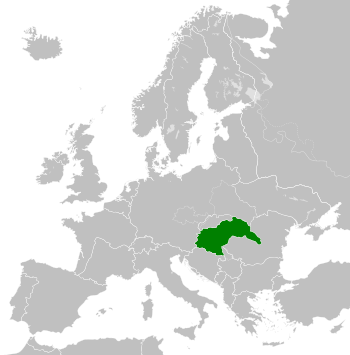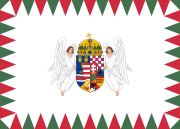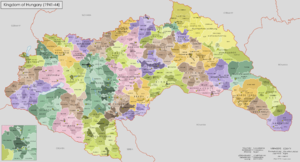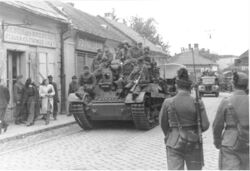مملكة المجر (1920-1946)
مملكة المجر (مجرية: Magyar Királyság), sometimes referred to as the Regency or the Horthy era, existed as a country from 1920 to 1946[أ] under the rule of Regent Miklós Horthy. Horthy nominally represented the Hungarian monarchy. In reality there was no king. Attempts by Charles IV to return to the throne were prevented by Horthy.
Hungary under Horthy was characterized by its conservative, nationalist and fiercely anti-communist character. The government was based on an unstable alliance of conservatives and right-wingers. Foreign policy was characterized by revisionism — the total or partial revision of the Treaty of Trianon, which had seen Hungary lose over 70% of its historic territory along with over three million Hungarians, who mostly lived in the border territories outside the new borders of the kingdom. Hungary's interwar politics were dominated by an obsession with the territorial losses suffered in this treaty.
Germany's influence in Hungary has led some historians to consider that the country increasingly became a client state of Germany after 1938.[7] The Kingdom of Hungary was an Axis Power during World War II, intent on regaining Hungarian-majority territory that had been lost in the Treaty of Trianon, which it did in early 1941. By 1944, following heavy setbacks for the Axis, Horthy's government negotiated secretly with the Allies, and also considered leaving the war. Because of this Hungary was occupied by Germany and Horthy was deposed. The extremist Arrow Cross Party's leader Ferenc Szálasi established a new Nazi-backed government, effectively turning Hungary into a German-occupied puppet state.
After World War II, Hungary fell within the Soviet Union's sphere of influence. It changed its name to the Hungarian State[8] (Hungarian: Magyar Állam) and the Second Hungarian Republic was soon thereafter established in 1946. In 1949, the communist Hungarian People's Republic was founded.
التشكل
Upon the dissolution and break-up of Austria-Hungary after World War I, the Hungarian Democratic Republic and then the Hungarian Soviet Republic were briefly proclaimed in 1918 and 1919, respectively. The short-lived communist government of Béla Kun launched what was known as the "Red Terror", involving Hungary in an ill-fated war with Romania. In 1920, the country fell into a period of civil conflict, with Hungarian anti-communists and monarchists violently purging the nation of communists, leftist intellectuals, and others whom they felt threatened by, especially Jews. This period was known as the "White Terror". In 1920, after the pullout of the last of the Romanian occupation forces, the Kingdom of Hungary was restored.
After the collapse of a short-lived Communist regime, according to historian István Deák:
- Between 1919 and 1944 Hungary was a rightist country. Forged out of a counter-revolutionary heritage, its governments advocated a “nationalist Christian” policy; they extolled heroism, faith, and unity; they despised the French Revolution, and they spurned the liberal and socialist ideologies of the 19th century. The governments saw Hungary as a bulwark against bolshevism and bolshevism’s instruments: socialism, cosmopolitanism, and Freemasonry. They perpetrated the rule of a small clique of aristocrats, civil servants, and army officers, and surrounded with adulation the head of the state, the counterrevolutionary Admiral Horthy.[9]
مملكة بدون ملك
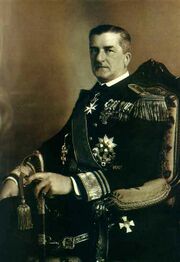
On 29 February 1920, a coalition of right-wing political forces united and returned Hungary to being a constitutional monarchy. However, it was obvious that the Allies would not accept any return of Charles IV. It was thus decided to select a regent to represent the monarchy. Miklós Horthy, the last commanding admiral of the Austro-Hungarian Navy, was chosen for this position on 1 March. Sándor Simonyi-Semadam was the first Prime Minister of Horthy's regency.
In 1921 Charles IV returned in Hungary and tried to retake its throne, even trying to march on Budapest with some rebel troops in October 1921; however, his attempts failed as much of the army remained loyal to Horthy and thus Charles was arrested and exiled to Madeira.
On 6 November 1921 the Diet of Hungary passed a law nullifying the Pragmatic Sanction of 1713, dethroning Charles IV and abolishing the House of Habsburg's rights to the throne of Hungary. Hungary was a kingdom without royalty. With civil unrest too great to select a new king, it was decided to confirm Horthy as Regent of Hungary. He remained in that powerful president-like status until he was overthrown in 1944.[10]
الحكم
Horthy's rule as Regent possessed characteristics such that it could be construed a dictatorship. As a counterpoint, his powers were a continuation of the constitutional powers of the King of Hungary, adopted earlier during the federation with the Austrian Empire.[11] As Regent, Horthy had the power to adjourn or dissolve the Hungarian Diet (parliament) at his own discretion; he appointed the Hungarian Prime Minister.[12]
The succession after Horthy's death or abdication was never officially established; presumably the Hungarian Parliament would have selected a new regent, or possibly attempted to restore the Habsburgs under Crown Prince Otto. In January 1942, Parliament appointed Horthy's eldest son István as Deputy Regent and expected successor. Whether this represents an attempt to gradually re-establish monarchy in Hungary is unclear; at any rate, István was killed in an airplane crash in August that year, and a new Deputy Regent was not appointed.
During his first ten years, Horthy led increased repression of Hungarian minorities. In 1920, the numerus clausus law formally placed limits on the number of minority students at university, and legalized corporal punishment for adults in criminal cases. Although the law seemingly applied in equal measure to all minorities, the ethnicity quota system was never fully introduced and the law acted largely to conceal anti-Jewish action from foreign observers.[13] Limitations were relaxed in 1928. Racial criteria in admitting new students were removed and replaced by social criteria. Five categories were set up: civil servants, war veterans and army officers, small landowners and artisans, industrialists, and the merchant classes.[14][15] Under István Bethlen as Prime Minister the electoral system was changed to reintroduce an open vote system outside Budapest and its vicinity and cities with county municipal rights.[16] Bethlen's political party, the Party of Unity, won repeated elections. Bethlen pushed for revision of the Treaty of Trianon. After the collapse of the Hungarian economy from 1929 to 1931, national turmoil pushed Bethlen to resign as Prime Minister. In 1938 the changes to the electoral system were reversed.[16]
Social conditions in the kingdom did not improve as time passed, as a very small proportion of the population continued to control much of the country's wealth. Jews were continually pressured to assimilate into Hungarian mainstream culture. The desperate situation forced the Regent, Horthy, to accept the far-right politician Gyula Gömbös as Prime Minister. He pledged to retain the existing political system. Gömbös agreed to abandon his extreme anti-Semitism and allow some Jews into the government.
In power, Gömbös moved Hungary towards a one-party government like those of Fascist Italy and Nazi Germany. Pressure by Nazi Germany for extreme anti-Semitism forced Gömbös out and Hungary pursued anti-Semitism under its "Jewish Laws". Initially, the government passed laws restricting Jews to 20 percent in a number of professions. Later it scapegoated the Jews for the country's failing economy.
In 1944, responding to the advancing Soviet forces, the Regent Miklós Horthy deposed the pro-German Prime Minister and installed a more balanced government in an effort to engage with the Allies and avoid occupation by the Soviet Union. Shortly afterward, German forces invaded Hungary, deposed Horthy as Regent, and installed a puppet regime led by Ferenc Szálasi of the anti-Semitic and pro-Nazi Arrow Cross Party. The Arrow Cross Party never abolished the Monarchy as a form of government, and Hungarian newspapers continued to refer to the country as the Kingdom of Hungary (Magyar Királyság), although Magyarország (Hungary) was used as an alternative.[17][18] From May to June 1944, Hungarian authorities rapidly rounded up and transported hundreds of thousands of Hungarian Jews to Nazi concentration camps, where most died.
After the fall of the Szálasi regime, a Soviet-backed government under Béla Miklós was nominally left in control of the entire country. A High National Council was appointed in January to assume the Regency, and included members of the Hungarian Communist Party, like Ernő Gerő, and later Mátyás Rákosi and László Rajk.
الاقتصاد
جزء من سلسلة عن |
|---|
| تاريخ المجر |
 |
Upon the kingdom's establishment soon after World War I, the country suffered from economic decline, budget deficits, and high inflation as a result of the loss of economically important territories under the Treaty of Trianon, including Czechoslovakia, Romania, and Yugoslavia.[19] The land losses of the Treaty of Trianon in 1920 caused Hungary to lose agricultural and industrial areas, making it dependent on exporting products from what agricultural land it had left to maintain its economy. Prime Minister István Bethlen's government dealt with the economic crisis by seeking large foreign loans, which allowed the country achieve monetary stabilization in the early 1920s. He introduced a new currency in 1927, the pengő.[20] Industrial and farm production rose rapidly, and the country benefited from flourishing foreign trade during most of the 1920s.[19]
Following the start of the Great Depression in 1929, the prosperity rapidly collapsed in the country, especially in part due to the economic effects of the failure of the Österreichische Creditanstalt bank in Vienna, Austria.[21] From the mid-1930s to the 1940s, after relations improved with Germany, Hungary's economy benefited from trade. The Hungarian economy became dependent on that of Germany.
السياسة الخارجية
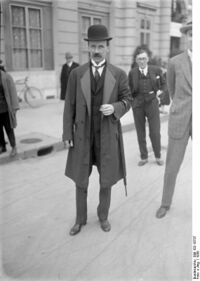
Initially, despite a move towards nationalism, the new state under Horthy, in an effort to prevent further conflicts, signed the Treaty of Trianon on 4 June 1920, thereby reducing Hungary's size substantially: the whole of Transylvania was taken by Romania; much of Upper Hungary became part of Czechoslovakia; Vojvodina was assigned to the Kingdom of Serbs, Croats, and Slovenes (known after 1929 as Yugoslavia); and the Free State of Fiume was created.
With a succession of increasingly nationalist Prime Ministers, Hungary steadily came to repent the Treaty of Trianon, and aligned itself with Europe's two fascist states, Germany and Italy, which both opposed the changes to national borders in Europe at the end of World War I. The Italian Fascist dictator Benito Mussolini sought closer ties with Hungary, beginning with the signing of a treaty of friendship between Hungary and Italy on 5 April 1927.[22] Gyula Gömbös was an open admirer of the fascist leaders.[23] Gömbös attempted to forge a closer trilateral unity between Germany, Italy and Hungary by acting as an intermediary between Germany and Italy, whose two fascist regimes had nearly come to conflict in 1934 over the issue of Austrian independence. Gömbös eventually persuaded Mussolini to accept Hitler's annexation of Austria in the late 1930s.[22] Gömbös is said to have coined the phrase "axis", which he applied to his intention to create an alliance with Germany and Italy; those two countries used it to term their alliance as the Rome–Berlin axis.[23] Just prior to the Second World War, Hungary benefited from its close ties with Germany and Italy when the Munich Agreement obliged Czechoslovakia and Hungary to settle their territorial disputes by negotiation. Finally, the First Vienna Award reassigned the southern parts of Czechoslovakia to Hungary, and shortly after Czechoslovakia was abolished Hungary occupied and annexed the remainder of the Carpatho-Ukraine.
الحرب العالمية الثانية
After the successful revision policy Hungary sought further solutions to the remainder of its former territories and demanded the concession of Transylvanian territory from Romania. The Axis powers were not interested in opening a new conflict in Central Europe; both countries were facing strong diplomatic pressures to avoid any military operations. Finally both parties accepted the arbitration of Germany and Italy, known as the Second Vienna Award, and as a result Northern Transylvania was assigned to Hungary. Shortly afterward, the Kingdom of Hungary joined the Axis powers. Hitler demanded that the Hungarian government follow Germany's military and racial agenda to avoid potential conflict in the future. Anti-Semitism was already an established political cause by the far right in Hungary. In 1944, after the ousting of Horthy by Hitler and before the installation of the National-Socialist Arrow Cross Party, the Hungarian government readily aided Nazi Germany in the deportation of hundreds of thousands of Jews to concentration camps during the Holocaust, where most of them died.[بحاجة لمصدر]
In April 1941, Hungary let the Wehrmacht into her territory, thus supporting Germany and Italy in the invasion of Yugoslavia. After the Independent State of Croatia was proclaimed, Hungary joined the military operations and was allowed to annex the Bačka (Bácska) region in Vojvodina, which had a majority of Hungarians, as well as the region of Muraköz (present-day Prekmurje and Medjimurje), which had large Slovenian and Croatian minorities, respectively.
On 27 June 1941, László Bárdossy declared war on the Soviet Union. Fearing a potential turn of support to the Romanians, the Hungarian government sent armed forces to support the German war effort during Operation Barbarossa. This support cost the Hungarians dearly. The entire Hungarian Second Army was lost during the Battle of Stalingrad.
By early 1944, with Soviet forces fast advancing from the east, Hungary was caught attempting to contact the British and the Americans to secretly escape the war and establish an armistice with the Allies. On 19 March 1944, the Germans responded by invading Hungary in Operation Margarethe. German forces occupied key locations to ensure Hungarian loyalty. They placed Horthy under house arrest and replaced Prime Minister Miklós Kállay with a more pliable successor. Döme Sztójay, an avid supporter of the Nazis, became the new Hungarian Prime Minister. Sztójay governed with the aid of a Nazi military governor, Edmund Veesenmayer.
By October of the same year, the Hungarians were again caught trying to quit the war, and the Germans launched Operation Panzerfaust. They replaced Horthy with Arrow Cross leader Ferenc Szálasi. A new pro-German "Government of National Unity" was proclaimed, and it continued the war on the side of the Axis. Szálasi did not replace Horthy as Regent, but was appointed as the "Nationleader" (Nemzetvezető) and Prime Minister of the new Hungarian Fascist regime.[بحاجة لمصدر]
On 21 December 1944, a Hungarian "Interim Assembly" met in Debrecen, with the approval of the Soviet Union. This assembly elected an interim counter-government headed by Béla Miklós, the former commander of the Hungarian First Army. At the end of March 1945, Szálasi's regime was driven out of Hungary.[24]
الفض
Under Soviet occupation, the fate of the Kingdom of Hungary was already determined. A High National Council was appointed as the country's collective Head of State until the monarchy was formally dissolved on 1 February 1946. The Regency was replaced by the Second Hungarian Republic. It was quickly followed by the creation of the Hungarian People's Republic.
تقييم تاريخي
There has been some debate as to what extent the Hungarian state of the 1930s and '40s can be classified as fascist. According to Richard Griffiths, the regime's increasing economic dependence on Germany, its passage of anti-Semitic legislation and its participation in exterminating local Jews all place it within the realm of international fascism.[25]
See also
- Hungary between the World Wars
- Hungary during World War II
- International relations (1919–1939) § Hungary
- Allied powers of World War II
- Axis powers of World War II
- Hungarian volunteers in the Winter War
Notes
- ^ The Allied powers generally did not recognize territorial evolutions of the Axis powers after the outbreak of World War II; however, this was not applied in all the cases after the end of the war. De jure, generally the Axis powers recognized the territorial evolutions of its powers. Special exceptions - also concerning non-belligerent parties - may have been possible.
Citations
- ^ "A m. kir. minisztérium 1939. évi 6.200. M. E. számú rendelete, a Magyar Szent Koronához visszatért kárpátaljai terület közigazgatásának ideiglenes rendezéséről" [Order No. 6.200/1939. M. E. of the Royal Hungarian Ministry on the provisional administration of the Subcarpathian territory returned to the Hungarian Holy Crown]. Magyarországi Rendeletek Tára (in الهنغارية). Budapest: Royal Hungarian Ministry of the Interior. 73: 855. 1939.
- ^ Fedinec, Csilla (2002). "A Kárpátaljai Kormányzóság idõszaka" [The period of the Governorate of Subcarpathia]. A kárpátaljai magyarság történeti kronológiája, 1918-1944 [Historical chronology of the Hungarians in Subcarpathia, 1918-1944] (PDF) (in الهنغارية). Galánta - Dunaszerdahely: Fórum Intézet - Lilium Aurum Könyvkiadó. p. 336. ISBN 80-8062-117-9.
- ^ أ ب ت Fogarasi, Zoltán (1944). "A népesség anyanyelvi, nemzetiségi és vallási megoszlása törvényhatóságonkint 1941-ben" [Distribution of the population by mother tongue, ethnicity and religion in the municipalities of Hungary in 1941.]. Magyar Statisztikai Szemle (in الهنغارية). Budapest: Royal Hungarian Central Statistical Office. 22 (1–3): 4, 13.
- ^ Kollega Tarsoly, István, ed. (1995). "Magyarország". Révai nagy lexikona (in الهنغارية). Vol. Volume 20. Budapest: Hasonmás Kiadó. pp. 595–597. ISBN 963-8318-70-8.
{{cite encyclopedia}}:|volume=has extra text (help) - ^ Kollega Tarsoly, István, ed. (1996). "Magyarország". Révai nagy lexikona (in الهنغارية). Vol. Volume 21. Budapest: Hasonmás Kiadó. p. 572. ISBN 963-9015-02-4.
{{cite encyclopedia}}:|volume=has extra text (help) - ^ Élesztős László; et al., eds. (2004). "Magyarország". Révai új lexikona (in الهنغارية). Vol. Volume 13. Budapest: Hasonmás Kiadó. pp. 882, 895. ISBN 963-9556-13-0.
{{cite encyclopedia}}:|volume=has extra text (help) - ^ Seamus Dunn, T.G. Fraser. Europe and Ethnicity: The First World War and Contemporary Ethnic Conflict. Routledge, 1996. P97.
- ^ "Az ideiglenes nemzeti kormány 1945. évi 539. M. E. számú rendelete az államhatalom gyakorlásával kapcsolatos egyes kérdések rendezéséről" [Prime Ministerial Decree No. 539/1945 of the Provisional National Government on the Settlement of Certain Issues relating to the Exercise of State Authority]. Magyarországi Rendeletek Tára (in الهنغارية). Budapest: Ministry of Interior of Hungary. 79 (1): 53–54. 8 March 1945.
- ^ István Deák, “Hungary” in Hans Roger and Egon Weber,eds., The European right: A historical profile (1963) p 364-407 quoting p. 364.
- ^ Thomas Sakmyster, Hungary's Admiral on Horseback (East European Monographs, 1994).
- ^ Sinor, Denis. 1959. History of Hungary, London: George Allen and Unwin Ltd. Pp. 289
- ^ Sinor, p. 289
- ^ Kovács, Mária (2012). "The Hungarian numerus clausus: ideology, apology and history, 1919-1945". In Karady, Victor; Nagy, Peter (eds.). The numerus clausus in Hungary: Studies on the First Anti-Jewish Law and Academic Anti-Semitism in Modern Central Europe. Budapest: Centre for Historical Research, History Department. p. 28. ISBN 978-963-88538-6-8.
- ^ See: Numerus Clausus
- ^ "A Numerus Clausus módosítása - The modification of the Numerus Clausus law". "http://regi.sofar.hu".
- ^ أ ب Romsics, Ignác. "Nyíltan vagy titkosan? A Horthy-rendszer választójoga". "www.rubicon.hu". RUBICONLINE.
- ^ Budapesti Közlöny, 17 October 1944
- ^ Hivatalos Közlöny, 27 January 1945
- ^ أ ب Signor, pp. 290
- ^ Signor, pp. 290.
- ^ Signor, pp. 291.
- ^ أ ب Sinor, pp. 291.
- ^ أ ب Sinor, pp. 291
- ^ Stanley G. Payne, A History of Fascism, 1914-1945, Routledge, 1996, page 420
- ^ Richard Griffiths, Fascism, p. 107, 111. London: Continuum, 2005. ISBN 0-8264-7856-5
External links
 Media related to History of Hungary between the World Wars at Wikimedia Commons
Media related to History of Hungary between the World Wars at Wikimedia Commons
| Preceded by Austria-Hungary
1867–1918 Hungarian Democratic Republic
1918–1919 Hungarian Republic
1919–1920 White Terror
1919–1921 |
Kingdom of Hungary also known as the Regency 1920–1946 |
Horthy regime (1920–1944)
succeeded by Second Hungarian Republic
1946–1949 People's Republic of Hungary
1949–1989 |
- CS1 الهنغارية-language sources (hu)
- CS1 errors: extra text: volume
- Pages using gadget WikiMiniAtlas
- Short description is different from Wikidata
- Articles containing إنگليزية-language text
- Pages using Lang-xx templates
- Articles containing مجرية-language text
- Articles with hatnote templates targeting a nonexistent page
- Portal-inline template with redlinked portals
- Pages with empty portal template
- Articles with unsourced statements from November 2011
- Articles with unsourced statements from July 2016
- Coordinates on Wikidata
- Kingdom of Hungary (1920–1946)
- ممالك سابقة
- Former polities of the interwar period
- Kingdom of Hungary
- Modern history of Hungary
- Territorial evolution of Hungary
- Hungary in World War II
- 1920s in Hungary
- 1930s in Hungary
- 1940s in Hungary
- States and territories established in 1920
- States and territories disestablished in 1946
- 1920 establishments in Hungary
- 1946 disestablishments in Hungary
- 20th century in Hungary
- Axis powers


